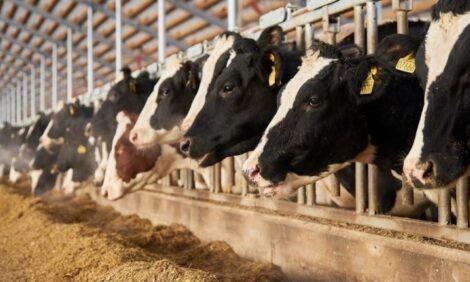



Taiwan Dairy and Products Annual Report 2011
Taiwan’s fluid milk production is forecast to reach about 379,000 metric tons in calendar year (CY) 2012, an increase of four per cent above the estimated CY 2011 production level, according to teh USDA Foreign Agricultural Service.Production:
Taiwan's CY 2012 fluid milk production is forecast to expand moderately, reaching nearly 379,000 metric tons. This reflects a natural growth rate of local cattle, which is estimated at about 3.8% annually. In 2010, the dairy cow and dairy goat populations were 55,296 and 31,667, respectively.
Taiwan’s domestic production accounts for 95% of total fluid milk market supply. In terms of product mix, dairy cattle account for 96% of the total with the remaining 4% supplied by goats.
Three key domestic processors -- WeiChuan, Uni President, and Kuan-Chuan -- account for 70% of fluid milk production, but there are 19 players in total. All of the processing plants purchase raw cow's milk from 579 dairy farms on an annual contract basis.
The Taiwan Council of Agriculture (COA) sets reference prices for raw milk corresponding to different fat percentages and solid nonfat percentage (SNF%). The minimum required fat content for raw milk is 2.8%. Effective October 1st 2011, the COA raised the average producer price for raw fluid milk by 7.99% to cover the increased costs of imported feeds. The reference prices per kilogram (kg) for raw milk are set at: US$0.73 for December through March; US$0.93 for April through May and October through November; and US$0.98 for June through September. These prices reflect higher consumer demand during the May-October period. Taiwan milk processors refer to these prices to negotiate pricing with dairy farmers as part of their annual contracts.
Given the inability of domestic producers to meet the growing demand for fresh milk, there have been inquiries about importing dairy cows to build up domestic herds. Due to animal quarantine restrictions and the high demand for dairy cattle imports by other competitive buyers, such as China, Taiwan has not imported any dairy cows since 2009. However, it is likely that the industry will be forced to import dairy cows in the coming years to meet the surging domestic demand for fresh milk.
According to Taiwan’s Bureau of Animal and Plant Health Inspection and Quarantine, cattle imports are prohibited from any country (zone) that has been designated as endemic for any of the following animal diseases: foot and mouth disease, rinderpest, contagious bovine pleuropneumonia and bovine spongiform encephalopathy.
The COA-authorized producer price increase for raw milk was followed by an average retail price hike of 10%, which generated complaints from consumers. These retail price hikes also caught the attention of Taiwan's Fair Trade Commission, which subsequently determined that the top three processors had engaged in price-fixing and slapped the three dairy companies with fines of up to NT$12 million (US$399,000) each.
Consumption:
CY 2012 fluid milk consumption is forecast to reach 406,000 metric tons. According to COA statistics, per capita consumption for fresh milk in Taiwan was 18.99 kg in CY 2009. Sales through the food service sector and convenience stores account for an estimated sixty percent of domestic consumption. The peak season for fluid milk consumption is from May to October, which accounts for 70% of annual sales. Taiwan consumers prefer whole fat milk (3.8% fat content), which accounts for 70% of the market.
The fluid milk end-user market size is estimated around US$300 million. The market is forecast to keep growing due to the robust demand in the food service sector, i.e. tea/coffee shops and convenience stores. The popularity of fluid milk in this sector is attributed to the 2008 melamine incident, when local media reports about imports of melamine-tainted Chinese milk powder caused consumers to shy away from any products containing milk powder. Consequently, tea/coffee shop owners started to promote fresh milk in place of the conventional low-cost milk powder in their specialty coffee and milk tea drinks. This marketing shift has created a premium appeal for consumers, and the idea of freshness has allowed tea/coffee shop owners to revamp their product offerings. In addition, double-digit growth for ready-to-drink coffee products in convenience stores will also increase demand for fresh milk. The National Animal Industry Foundation estimates that the demand for fresh milk in this sector is 150 metric tons per day.
Trade:
Taiwan Imports of Fluid Milk (HS Code: 0401)

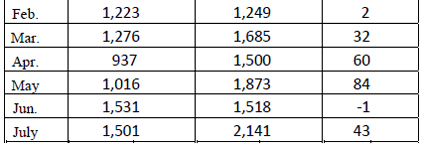
Imports of fluid milk have increased by 24% in the first seven months of CY 2011 compared to the same period in CY 2010. Currently New Zealand has the largest market share (35%) of Taiwan imports of fluid milk, forecast to reach 6,800 tons in 2011. France ranks the second, holding 23% of market share, forecast to reach 4,500 tons in 2011. Due to the continuing robust demand and insufficient domestic production, imports for CY 2012 are forecast to grow by 20%, reaching 27,000 metric tons.
Policy:
Tariff Rate Quota (TRQ)
With Taiwan’s accession to the WTO on January 1, 2002, imports of formerly-banned fluid milk are subject to Tariff Rate Quota (TRQ) and Special Safeguards (SSG) controls.
- Taiwan adopted the system II of TRQ rules to regulate imported fluid milk. The import rights are auctioned once a year. All importers registered with Taiwan’s Board of Foreign Trade (BOFT) are eligible to bid on quota rights. Quota allocation certificates serve as automatic import licenses for fluid milk imports. The minimum quantity for the bidding is 250 MT. The annual TRQ volume for fluid milk is 21,298 MT. The duty for in-quota fluid milk is 15% and NT$15.6 per kg for out-of-quota duty, equivalent to US$520 per MT.
- In November 2010, 10 companies successfully bid for 13,490 MT of the 2011 TRQ. The importers reportedly were able to win the bid by paying a minimum tender operation fee of US$16 per metric ton. The 2012 TRQ for fluid milk will be auctioned in November 2011 and March 2012. The low fill rate reflects the consumption habits of Taiwan consumers, who prefer fresh milk. Due to transport and storage issues, fluid milk exports to Taiwan are extended shelf life milk, which is not popular in retail outlets.
Imports Data of Fluid Milk (unit: MT)

The Ministry of Finance (MOF), which is responsible for the TRQ allocations, has entrusted the Bank of Taiwan (BOT) to implement the TRQ application and allocation process. All relevant TRQ information can be retrieved from the BOT website: http://www.bot.com.tw/Trade/Pages/default.aspx.
Special Safeguards (SSG)
The Taiwan government also adopted Special Safeguards (SSG) to control the volume of imported fluid milk. The Taiwan’s Department of Treasury determines a quantity trigger and a unit base price trigger of fluid milk. If the imports of fluid milk exceed the SSG quantity trigger or fall below its SSG unit price trigger, they are subject to out-of-quota duty. Imports beyond the TRQ and above the SSG’s quantity triggery are subject to an additional 33.3% surcharge. The COA’s 2011 SSG quantity trigger for fresh milk in 2011 is 861 MT; the SSG trigger for other fluid milk is 6,174 MT.
SSG Import Duties:
- Fluid milk: For imports within the TRQ volume, the tariff is subject to 15%. For imports out of the TRQ volume, the tariff applies to NT$15.6 per kg, equivalent to US$520 per metric ton.
- For imports above SSG’s quantity trigger, an additional 33.3% surcharge is applied.
- Goat/sheep milk applies to the tariff of 20% and is not subject to any TRQ or SSG limits.
Fresh Milk Seals
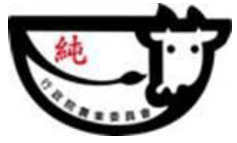
The COA has been actively promoting its domestic fresh milk seal to consumers. As a result, Taiwan consumers have been educated to think that fresh milk with the authorized seal on the packaging is of better quality.
Only domestic registered processing plants are eligible to apply for fresh milk seals from the COA for use on finished product packages. The COA reviews each application and strictly controls the number of authorized seals issued based on the volume of raw milk that these processing plants purchase from local dairy farms.
Example of the Fresh Milk Seal authorized and issued by the COA.
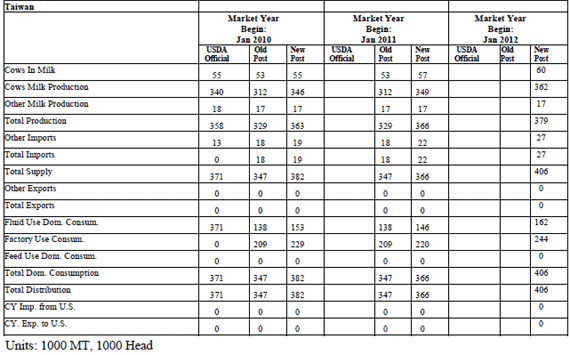
Production:
Taiwan doesn’t produce cheese in commercial quantity.
Consumption:
Taiwan’s CY 2012 cheese consumption is forecast to reach 25,000 metric tons, growing by 10% compared to CY 2011. This growth is expected to come primarily from increased consumption in the foodservice sector and further demand growth in the food retail sector, driven in large part by Costco's continued expansion. Cheese consumption in the food service segment has the potential to grow even further given new applications for mozzarella and cheddar cheese in increasingly popular western-style dishes. However, local chefs still need to be educated on the wide variety of cheese products and applications.
Sliced cheeses account for 65% of consumption in the retail sector. On a per capita basis, cheese consumption in Taiwan is still very small (0.9 kg in 2010) compared to most Western countries and Japan. However in recent years, Taiwan consumers have started to acquire a taste for an assortment of cheese products. In the past, consumers tended to associate cheese only with pizza or sandwiches. Nowadays, however, consumers eat cheese in a variety of foods and meals. For example, cheese is becoming increasingly popular as a topping for baked potatoes.
Trade:
Taiwan cheese imports in the first seven months of CY 2011 reached 14,267 metric tons, up 14% compared to the same period in 2010. New Zealand holds the largest market share (33%) of Taiwan’s cheese imports. Both New Zealand and Australia are strong competitors in the low-priced cheese segment, targeting the food retail sector.
Cheese imports from the United States grew by 20% in the first half of 2011 because of new varieties being used in the food service sector, particularly in bakeries, as well as increased retail sales due to the continued expansion of Costco in cities throughout Taiwan. U.S. cheese exports to Taiwan are expected to continue to grow at a rate of at least 10 percent each year, especially for use in the food service sector.
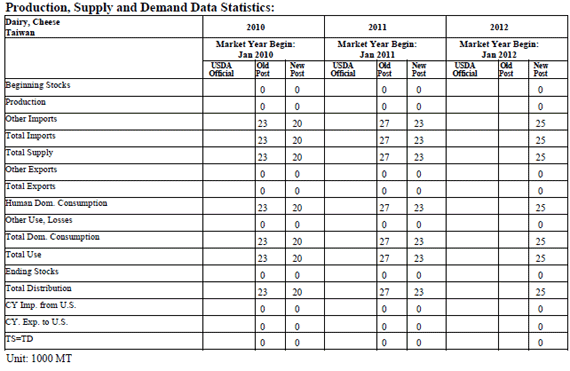
Production:
Taiwan doesn’t produce milk powder in commercial quantity.
Consumption:
Taiwan’s CY 2012 milk powder consumption is forecast to rise by 20%, reaching 37,000 metric tons, which reflects the robust demand in the Taiwan baking sector.
Trade:
To help ease the pressure of inflation, the Taiwan Ministry of Finance lowered the tariff on milk powder by 25% for the six month period ending in February 2012. Taiwan’s imports of milk powder are forecast to grow by 20% in CY 2012, reaching 37,000 metric tons. The Taiwan branch of Fronterra, which has a special trade partnership with New Zealand suppliers, accounts for 80% of Taiwan’s milk powder imports. Whole-fat milk powder is used predominately in baking and is very price-sensitive.
Several food safety incidents, including the plasticizer incident that occurred earlier in 2011 and the 2008 melamine incident, changed the traditional buying criteria for Taiwan importers and bakers. Before these food safety events, bakers didn’t consider the origin/source of milk powder as long as it was price competitive. After these occurrences, product origin became a major concern for consumers, which subsequently influenced buyer’s purchasing decisions. In fact, in accordance with Taiwan’s Department of Health regulations, imports of milk powder from China have been banned since the melamine incident in 2008.

Production:
Taiwan doesn’t produce butter in commercial quantity.
Consumption:
Taiwan’s CY 2012 butter consumption is forecast to grow by 20%, reaching 24,800 metric tons. The growth in demand is expected to come largely from the continued expansion in the bakery sector.
In the past, domestic processing plants made use of milk waste to produce butter, which was considered a cheap side-product, and sold it to bakeries. However, at present, domestic plants do not have the capacity to produce enough butter due to the surging domestic demand for milk. As a result, imports of butter are expected to continue to grow.
Trade:
Taiwan’s imports of butter are forecast to increase by 20% in CY 2012 to keep pace with increased domestic consumption. New Zealand typically accounts for 65% of the market share due in large part to the success of the Anchor brand in the local baking industry. Anchor has the first-mover advantage and has positioned itself as a butter of high quality through an intensive mass media branding campaign. Taiwan bakers are convinced of the product principal advantage, a stable high melting point, which they reportedly cannot find in other brands.
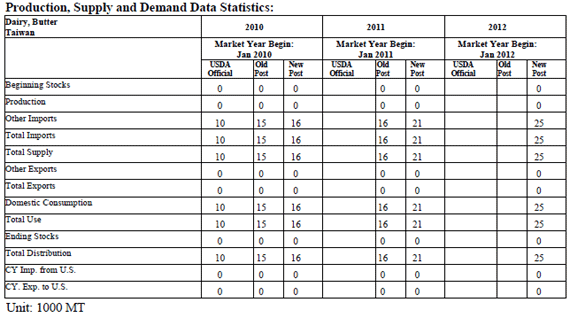
Production:
Taiwan doesn’t produce whey in commercial quantity.
Consumption:
Taiwan’s CY 2012 whey consumption is forecast to reach 8,800 metric tons. Local yogurt production accounts for the biggest use by volume but is also the most price-sensitive segment for whey. According to industry contacts, yogurt consumption has dropped over the past two years due to consumer concerns following media reports on yogurt’s high sugar content.
Domestic yogurt manufacturers typically produce other dairy products in addition to yogurt. Therefore, these companies need to purchase a variety of dairy ingredients from importers, such as milk powder, whey, etc. A handful of importers dominate Taiwan’s imports of whey products. The biggest importer of milk powder is able to take advantage of bundle-selling at competitive prices.
Taiwan's food processing and baking sectors buyers are still not fully aware of the characteristics of whey protein compared to soy protein and milk powder. In particular, the industry is concerned about whey protein’s bland flavor and prices that are twice as high as milk powder and soy protein.
Trade:
Taiwan’s imports of whey in CY 2010 declined to 12,982 metric tons, down 15% compared to 2009, although the market value grew by 25%. The decline in import volume was attributed to an unstable supply of Australian whey. Imports in CY 2011 are expected to continue decline further, falling further to 11,000 metric tons. The CY 2012 forecast for whey imports is 9,350 tons.
Though over all imports of whey are declining, there is growing demand for high-end whey products. Taiwan’s imports of whey protein concentrate (WPC) grew by nearly 200% during the first seven months in CY 2011 compared to the same period in CY 2010. The key suppliers are the Netherlands, holding a 58% market share, and the United States, which accounts for 30%. The CY 2012 forecast for WPC imports is 863 tons.
Other:
The U.S. Dairy Export Council (USDEC) represents the U.S. dairy industry in Taiwan. The council’s staff provides market intelligence on trade policy and market access issues, and develops marketing activities to promote U.S. dairy products to Taiwan trade contacts and consumers. Below, please find contact information for the USDEC Taiwan office.
Further Reading
| - | You can view the full report by clicking here. |
November 2011


